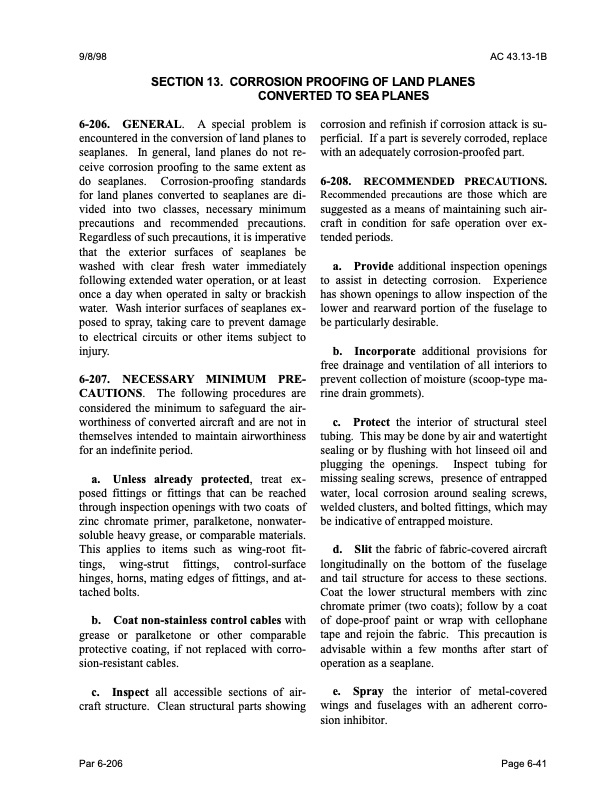
PDF Publication Title:
Text from PDF Page: 309
9/8/98 AC 43.13-1B SECTION 13. CORROSION PROOFING OF LAND PLANES CONVERTED TO SEA PLANES 6-206. GENERAL. A special problem is encountered in the conversion of land planes to seaplanes. In general, land planes do not re ceive corrosion proofing to the same extent as do seaplanes. Corrosion-proofing standards for land planes converted to seaplanes are di vided into two classes, necessary minimum precautions and recommended precautions. Regardless of such precautions, it is imperative that the exterior surfaces of seaplanes be washed with clear fresh water immediately following extended water operation, or at least once a day when operated in salty or brackish water. Wash interior surfaces of seaplanes ex posed to spray, taking care to prevent damage to electrical circuits or other items subject to injury. 6-207. NECESSARY MINIMUM PRE- CAUTIONS. The following procedures are considered the minimum to safeguard the air worthiness of converted aircraft and are not in themselves intended to maintain airworthiness for an indefinite period. a. Unless already protected, treat ex posed fittings or fittings that can be reached through inspection openings with two coats of zinc chromate primer, paralketone, nonwater soluble heavy grease, or comparable materials. This applies to items such as wing-root fit tings, wing-strut fittings, control-surface hinges, horns, mating edges of fittings, and at tached bolts. b. Coat non-stainless control cables with grease or paralketone or other comparable protective coating, if not replaced with corro sion-resistant cables. c. Inspect all accessible sections of air craft structure. Clean structural parts showing corrosion and refinish if corrosion attack is su perficial. If a part is severely corroded, replace with an adequately corrosion-proofed part. 6-208. RECOMMENDED PRECAUTIONS. Recommended precautions are those which are suggested as a means of maintaining such air craft in condition for safe operation over ex tended periods. a. Provide additional inspection openings to assist in detecting corrosion. Experience has shown openings to allow inspection of the lower and rearward portion of the fuselage to be particularly desirable. b. Incorporate additional provisions for free drainage and ventilation of all interiors to prevent collection of moisture (scoop-type ma rine drain grommets). c. Protect the interior of structural steel tubing. This may be done by air and watertight sealing or by flushing with hot linseed oil and plugging the openings. Inspect tubing for missing sealing screws, presence of entrapped water, local corrosion around sealing screws, welded clusters, and bolted fittings, which may be indicative of entrapped moisture. d. Slit the fabric of fabric-covered aircraft longitudinally on the bottom of the fuselage and tail structure for access to these sections. Coat the lower structural members with zinc chromate primer (two coats); follow by a coat of dope-proof paint or wrap with cellophane tape and rejoin the fabric. This precaution is advisable within a few months after start of operation as a seaplane. e. Spray the interior of metal-covered wings and fuselages with an adherent corro sion inhibitor. Par 6-206 Page 6-41PDF Image | AFS-640

PDF Search Title:
AFS-640Original File Name Searched:
ac_43.13-1b_w-chg1.pdfDIY PDF Search: Google It | Yahoo | Bing
5,000 BF Shipping Container Lumber Dry Kiln For Quality Lumber The 5,000 BF container kiln consists of one 40 foot high-cube aluminum shipping container... More Info
Shipping Container Lumber Dry Kilns by Global Energy Global Energy designed and developed the container kiln back in 1991. The purpose is to give access to portable sawmill owners, furniture makers, and small business the value added profit of dry kiln lumber and quality hardwoods... More Info
Vacuum Kiln Conversion Kit for Lumber and Wood Dry Kilns Convert your existing conventional dry kiln into a fast drying vacuum kiln. Similar to vacuum bagging in the boat building and aircraft industry, we have come up with a proprietary process which allows you to build a very simple vacuum kiln at a fraction of the price, and without the intensive conventional metal chamber structure... More Info
Vacuum Pump Cart System for Bagging Clamping Wood Drying and more Vacuum Cart with 2HP Pump and Dual Pistons with multiple multiplex vacuum ports and liquid reservoir... More Info
Vacuum Bagging Basics Vacuum bagging is a method of clamping, which has traditionally been used in the composites industry, but can also be used for vacuum drying materials, including wood products... More Info
| CONTACT TEL: 608-238-6001 Email: greg@globalmicroturbine.com | RSS | AMP |